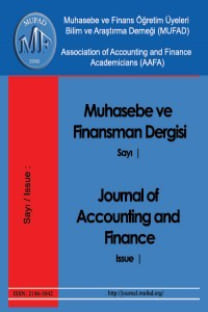Sistematik riskin belirleyicileri: İmkb'de sektörel karşılaştırma
The determinants of systematic risk: sectorial comparison in ise
___
- Aksoy Ahmet-Tanrıöven Cihan. (2007), Sermaye Piyasası Yatırım Araçları ve Analizi, Ankara.
- Beaver, William- Ketler, Paul-Scholes, Myron. (1970), The Association Between Market Determined and Accounting Determined Risk Measures, The Accounting Review, October, p. 645-682
- Berkowitz, Michael K. (1998), Estimating the Market Risk for Nontraded Securities: An Application to Canadian Public Utilities, International Rewiev of Financial Analysis, Vol.7, No.2, p.171-179.
- Browman, Robert G. (1979), The Theoretical Relationship Between Systematic Risk and Financial (Accounting)Variables, The Journal of Finance, Vol. 34., No.3, p.617-630.
- Castagna, A.D.- Z.P. Matolcsy (1978), The Relationship Between Accounting Variables and Systematic Risk and the Prediction of Systematic Risk, Australian Journal of Management, Vol.3, p.113-126.
- Ceylan Ali-Korkmaz Turhan. (2004), Sermaye Piyasası ve Menkul Değer Analizi, Bursa. Chang, Chei- Robert, Chiou, K. Su (2004), On the Relation of Systematic Risk and Accounting Variables, Asian FA/TFA/FMA 2004 Conference Clyde J. Crobaugh -Amos E.Redding, (1964), Casualty Insurance, New Jersey.
- Damadoran, Aswath (2002), Investment Valuation, Tools and Techniques for Determining the Value of Any Asset, United States of America.
- Demirtaş, Özgür- Güngör, Zülal (2004), Portföy Yönetimi ve Portföy Seçimine Yönelik Uygulama, Havacılık ve Uzay Teknolojileri Dergisi, Cilt 1, Sayı 4, s.103-109.
- Douglas, R. Emery-John, D. Finnerty- John, D. Stowe (2004), Corporate Financial Management, United States of America.
- Eryiğit, Canan- Eryiğit, Mehmet (2009), Temel Finansal Oranların Sistematik Riske Etkisi, Đktisat Đşletme ve Finans Dergisi, Cilt 24, Sayı 281, s.60-76.
- Hamada, Robert S. (1972), The Effect of the Firms Capital Structure on the Systematic Risk of Common Stock, The Journal of Finance, Vol.27, p. 437-452.
- Jan, Mossin (1966), Equilibrium in A Capital Asset Market, Econometrica, Vol.34, No.4, p. 768-783.
- John, Linter (1965), The Valuation of Risk Assets and the Selection of Risky Investments in Stock Portfolios and Capital Budgets, The Review Of Economics and Statistics, Vol.47, No.1, p. 13-37.
- Kee, Yew, Ho- Xu, Zhenyu- Meng, Chee Yap (2004), R&D Investment and Systematic Risk, Accounting and Finance, Vol. 44, p.393-418.
- Kırlı, Mustafa (2006), Halka Açık Olmayan Şirketlerde Sistematik Risk Ölçütü Beta Katsayısının Tahmin Edilmesi, Celal Bayar Üniversitesi ĐĐBF Yönetim ve Ekonomi Dergisi, Cilt 13, Sayı 1, s. 121-134.
- Leigh, McAlister- Raji, Srinivasan- MinChung, Kim. (2007), Advertising, Research and Development and Systematic Risk of the Firm, Journal of Marketing, Vol. 71, p.35- 48.
- Lev, Baruch (1974), On the Association between Operating Leverage and Risk, Journal of Financial and Quantitative Analysis, September, p.627-641.
- Pike, Richard- Neale, Bill (2003), Corporate Finance and Investment, Decision and Strategies, United Kingdom.
- Sharpe, William F. (1964), Capital Asset Prices: A Theory of Market Equilibrium Under Conditions of Risk, The Journal of Finance, Vol.19, No.3, p.425-442.
- Türko, Metin (2002] Finansal Yönetim, İstanbul.
- ISSN: 2146-3042
- Yayın Aralığı: 4
- Başlangıç: 2005
- Yayıncı: Muhasebe ve Finansman Öğretim Üyeleri Derneği (MUFAD)
Türkiye'de ve dünyada organize türev piyasaların gelişimi
The forecasting of stock prices in ıse ınsurance ındex with artificial neural networks
Sistematik riskin belirleyicileri: İmkb'de sektörel karşılaştırma
Emine Ebru AKSOY, Cihan TANRIÖVEN
Menkul kıymetleştirme şirketleri fannie mae ve freddiemac nasıl kurtarılabilir? 1
Examination of self-selection bias and big $N^{1}$ audit fee premiums-evidence from norway2
Konut finansmanı sistemi ve Türkiye'de Toki uygulamalarının analizi
